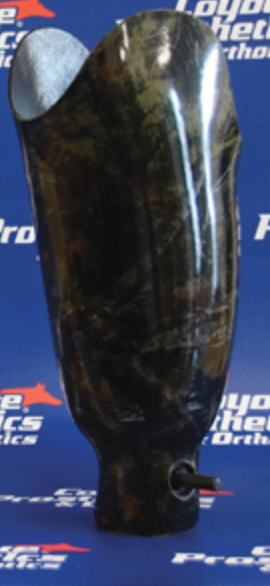Basalt fiber gives prosthetics more “give”
Prosthetics and orthotics often take advantage of composite materials’ strength and durability. Basalt fiber has given manufacturer Coyote Design (Boise, ID, US) a performance edge.
Prosthetics and orthotics often take advantage of composite materials’ strength and durability. One application in particular that benefits from composites are sockets, custom-shaped, hollow forms into which an amputee’s stump fits; sockets also include hardware that accepts limb or hand/foot attachments. Manufacturer Coyote Design (Boise, ID, US) is well known for its composite “definitive sockets” (as distinguished from temporary, typically plastic, test sockets, for fit testing). To produce a socket, a hollow cast is made of the patient’s stump and is then filled with plaster to create a positive shape. That plaster shape, fitted with a hollow pipe for handling inserted in the center, becomes the mold for the composite socket layup. The layup is wet-out with resin with the help of a vacuum (via the hollow pipe) and cured at room temperature, often with the help of a heat blanket, says Coyote Design’s Rod Smith, director of marketing.
Dale Perkins, Coyote Design’s cofounder, was an early adopter of composites and was not afraid to try new or exotic composite reinforcements. For example, one amputee patient and avid outdoor enthusiast (and who later summitted Mt. Everest) suggested using aramid for a tough prosthetic. However, several sockets made with that fiber failed, due to a lack of adhesion to the polyester resin Perkins was using at the time. Materials improved with the advent of carbon fiber braided tubes, or “socks,” wet out with epoxy resin or acrylic-modified epoxy. Carbon fiber prosthetic sockets exhibited good mechanical performance, but the material’s brittleness caused a high rate of cracking failure, and patients often reported uncomfortable stiffness. In addition, manufacturing with carbon fiber required masks, protective gear and dust collection systems for health and safety.
After several years of searching for alternatives to carbon fiber, the company decided to try basalt fiber, which is similar to glass fiber but made from quarried basaltic rock. The goal, says Perkins, was to test whether the material could provide more flexibility and comfort for patients: “Using basalt fiber braid combined with nylon fiber braid gave us a socket that had the flexural characteristics we wanted, with dramatic reductions in structural failures.” The basalt braid is sourced from a proprietary supplier.
Related Content
-
Urban furniture project demonstrates green potential for composite 3D printing and recycled materials
Large-format AM specialist Caracol and partners designed custom, 3D-printed outdoor furniture with glass fiber-reinforced recycled polypropylene, and conducted an LCA to evaluate and improve the process.
-
Composite wrap system combats corrosion in industrial tank repair
A fiberglass and carbon fiber composite wrap system enabled an Australian nickel mine to quickly repair a stainless steel ammonium sulphate feed tank and protect against future corrosion.
-
Nanomaterials optimize performance of space-ready carbon fiber composite panels
A recent ESA project led by Adamant Composites aimed to mature nanomaterial-enhanced CFRP for lighter weight, more thermally and electrically conductive materials for manufacturing satellite structures.














